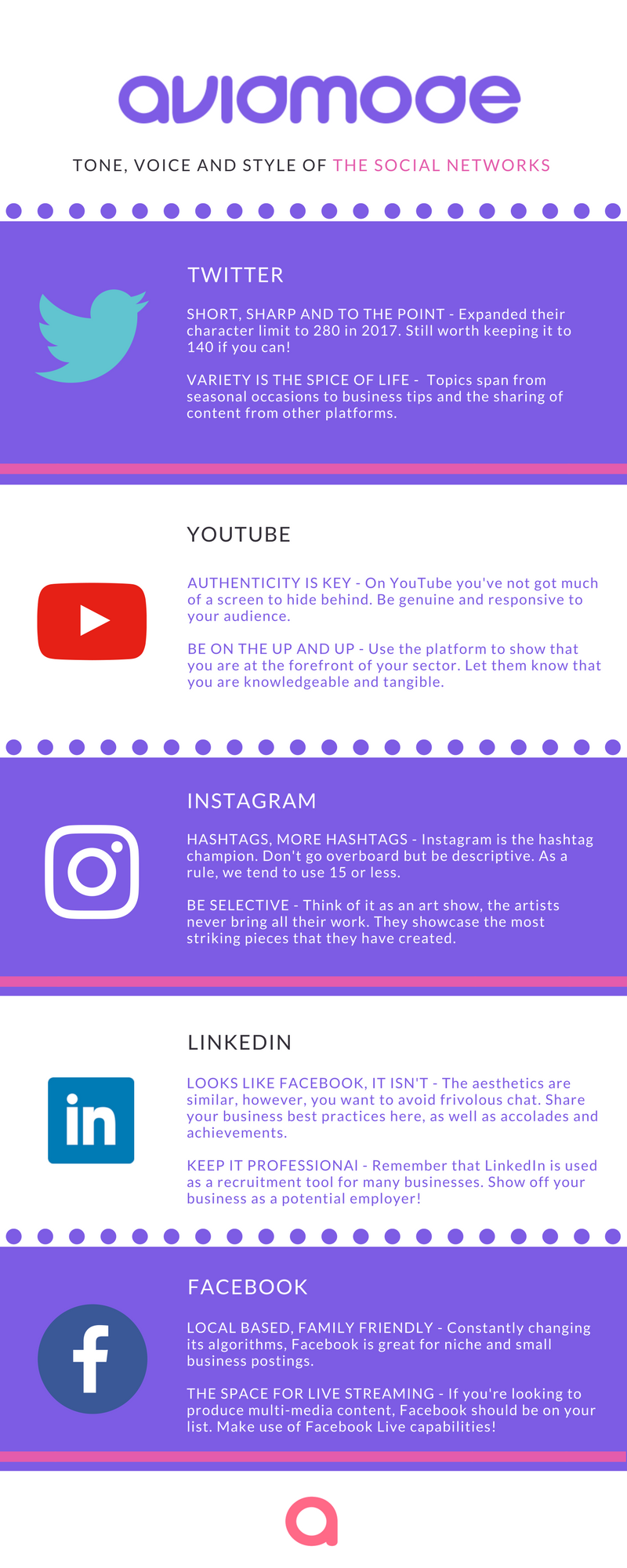Tone, voice and style
Firstly, let’s look at the differences between Tone, Voice and Style. Here are their official definitions: Tone – “a particular quality, a way of sounding, modulation, or intonation of the voice…
Firstly, let’s look at the differences between Tone, Voice and Style. Here are their official definitions:
Tone – “a particular quality, a way of sounding, modulation, or intonation of the voice as expressive of some meaning, feeling, spirit, etc.:”
Voice – “a range of such sounds distinctive to one person, or to a type of person or animal.”
Style – “a particular, distinctive, or characteristic mode of action or manner of acting.”
As a small business, back in the pre-internet era, you would have had experience talking to your customers face to face. As the customer walked into the shop you could gauge their specific demographics, your communication style (tone and voice) would then automatically change to reflect your assumptions.
Humans are fine-tuned to take in external cues and interact based on those cues. In a face to face interaction, the tone, voice and style that you use come almost instantly, in the same way that a chameleon changes its colours!
Larger businesses, especially Multi-National Corporations (MNC) have been using the concept of voice, tone and style much longer than their smaller counterparts. They’ve had the advantage of expensive consultants, because of the large amounts of customers they serve it became a necessity to treat customers in a specific manner rather than on an ad-hoc basis.
The internet and the businesses that run on it are in a similar situation to the old MNCs. The reach of Internet-based companies can be far and wide. Their communications have the potential to reach millions of people simultaneously in public view each day, and thus their ability to be a communication chameleon is greatly diminished. You, as a business, have no way to physically see your audience online. They, in turn, are able to see you so it’s important to impress your brand personality on your customers with a united voice, tone and style that represent you as a business.
So, this is the part where we take some inspiration from Anna Wintour of Vogue and create a style guide for our businesses, perhaps with a little less fashion advice!
Here are some of the considerations to take into account when creating your business style guide. These will be different depending on the type of business you run so it’s best to answer these questions for yourself!
Yes, you need to reevaluate your market research!
This is probably the most important part of compiling your style guide. If you don’t know who your audience is or your scope is too large you’ll find yourself up a river without a paddle. Market research is probably something that you did as part of a business plan when starting your business, so think back and work out if that’s who you really want to be targeting and are currently serving.
When looking at the market research take a glance at the demographics and segmentation of your audience. This will include important information such as age, location, marital status, occupation, lifestyle and hobbies etc. This gives you a great idea of who you want to be targeting.
If you already have your business off the ground and social media accounts running you may also have analytics which will show you similar information using your follower’s data on said social channels.
You want to build your brands tone, voice and style around these key data sets. This will make sure that you are reaching out to the right audiences and ultimately serving their wants and needs.
What is your brand personality?
Take a look at your branding, your logo, the colours that you use, the catchphrases that you may have. All of this will give you an idea of the “personality” of your brand.
A fantastic way to build up your style guide is by looking at what you already have. Come up with a few adjectives that best describe your brand/business based on the point mentioned above.
For example, if you tend towards bright colours and your logo is a cartoon elephant then you might think of words such as “fun-loving, amusing or perhaps entertaining”. You can then use these phrases to create the underlying style for the content that you create and the communication that your company makes to the world.
Your style guide and social media
Keep in mind that different social media networks all have their styles and uses. The networks that you choose to use as marketing channels should also match your tone, voice and style choices. It could be that different segments of your audience use different social channels and you will need to tailor your content specifically for each of these channels and audiences, whilst maintaining your integrity and brand personality. It can be done and done well, but it is a fine balancing act because it can be all too easy to get wrong.
Below are our tips and tricks infographic for working with the Social Networking sites.
There are so many brands out there that have a distinctive voice when communicating over the web. Can you think of any in particular that you’ve had experience with?
Thanks to Dogancan Ozturan on Unsplash for the featured photo!
If you enjoyed reading this blog post, check out similar ones in the sidebar. Feel free to get in touch with to chat about your latest project ideas - we love a good excuse for more tea.



